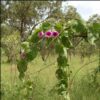Desert Yam
$5.99
Ipomoea Costata
- Seed Count 5
- Native Potato
- Perennial
In stock
Description
The Desert Yam, also known as Rock Morning Glory, is a perennial plant that is a is a master of adaptation. Found across the dry interior regions of Western Australia, the Northern Territory, and parts of South Australia, it has evolved to endure extreme heat, sporadic rainfall, and nutrient-poor soils. Its silvery-green leaves, thick and fleshy to conserve moisture, form a low-growing mat that hugs the ground, creating a textural contrast in garden beds or rockeries.
But the real showstopper arrives in the warmer months, when large, trumpet-shaped flowers emerge. These blooms, often pinky-white with a subtle darker pink throat, unfurl in the cool of the morning and retreat by midday—a clever dance to avoid the harsh sun. After flowering, it produces woody seed pods that blend discreetly into the landscape, ensuring its persistence through dry spells. For those aiming to create a water-wise garden or restore a patch of land with native flora, the Desert Yam is a practical choice.
This fast-growing creeper and can send out long tendrils that stretch up to 3 meters. These tendrils will also scale shrubs and trees to several meters in height, so care is needed when choosing its growing location. As Bush Tucker, the Desert Yam is sweet and juicy and is delicious when sliced and fried, roasted or baked. It can also be eaten raw.
Three types of tuber can be found under the one bush. The first is found on the long runners which occasionally send down roots, but usually only in good seasons. The second type of tuber is produced on the parent’s lateral roots – up to 3 m from the plant base. The third type is found directly below the mature plant. These can be hard and woody because of their age.
Traditional uses/preparation: When eaten fresh like an apple, the white flesh is firm, juicy and slightly sweet very much like the Jicama from Mexico. Roasted whole in the ashes of a fire and eaten hot they taste very similar to the common sweet potato.
In cultivation, its versatility shines. Whether sprawling across a rocky garden, softening the edges of a gravel path, or adding contrast to succulent arrangements, this plant requires little beyond a sunny spot and well-drained soil. Its sprawling habit makes it ideal for erosion control on slopes, while its salt tolerance opens possibilities for coastal gardens.
Seed Pre-Treatment
To break dormancy and improve germination:
- Hot Water Treatment: Place seeds in a cup, cover with just boiled water, and soak for 12–24 hours.
- Alternative Scarification: Gently nick the seed coat, avoiding the embryo and soak in lukewarm water for 24–48 hours.
Drain seeds before sowing.
Sowing Guidelines
When to Sow:
- Best in spring to early summer, September – December, to align with warm temperatures (20–25°C) for germination.
- Sow seeds 1 cm deep in trays or pots.
Soil and Containers:
- Use a well draining mix such as a cactus soil, sandy loam, or potting mix with ⅓ gravel/pumice).
Germination:
- Keep soil moist but not water logged, place in bright, indirect light.
- Germination typically occurs in 2–4 weeks.
Growing Conditions
Climate:
- Native to arid/semiarid regions, WA, NT, QLD, but adapts to temperate zones.
- Frost sensitive where the above ground parts die back, but the tubers survive.
Sunlight:
- Full sun to partial shade (6+ hours of direct sun ideal).
Soil:
- Thrives in sandy, rocky, or loamy soils with excellent drainage.
- Tolerates poor soils but avoid waterlogging.
pH:
- Neutral 6.0 – 7.5.
Spacing:
- Plant seedlings 1–2 m apart to accommodate its creeping/climbing habit (up to 3 – 6 m long).
Care and Maintenance
Watering:
- Growing season spring–autumn: Water deeply but allow soil to dry between sessions.
- Winter: Reduce watering and treat like cacti to prevent tuber rot.
Fertilising:
- Use a low nitrogen, balanced fertiliser (e.g., compost tea) to encourage tuber growth.
- Avoid excessive nitrogen.
Support:
- Provide a trellis or structure for climbing.
- Prune to manage growth.
Pests/Diseases:
- Watch for spider mites, especially in greenhouses and root rot from overwatering.
Harvesting Tubers
Timing:
- Late autumn, when foliage dies back.
Method:
- Dig 0.5 – 1 m deep to locate tubers.
- Lateral tubers are crisper; main tuber is fibrous.
- Rebury smaller tubers to encourage regrowth.
Culinary Use: Cook tubers like sweet potatoes (roast, boil, or bake).
Key Tips for Success
Drainage is critical:
- Use raised beds or slopes in humid areas.
Frost protection:
- Mulch tubers in winter if grown in cooler regions.
Seed toxicity:
- Handle seeds carefully; they may be toxic if ingested.
Postage Charge
Orders under $30 attract a $4.50 shipping charge. Orders $30 and above have free shipping.
Order Times
Seed orders are normally dispatched within three business days. You will receive an email when seeds are mailed out.
Postage Days
Seeds are mailed out Monday to Friday at 1pm. Except for the Friday of long weekends.
Postage Times
WA 2-3 Days: SA,NT 3-5 Days: NSW, ACT, QLD, VIC: 5-7 Days
Carrier
We use Australia Post Letter Postage for the majority of orders
Not only are our seeds packed in recycled paper envelopes, we keep the theme going when we post out website orders. To protect your seeds from moisture and the letter box munchers (snails), we use a very special plastic free material made from plants. They are then put into recycled mailing envelopes. Green all the way 💚🌿
















Reviews
There are no reviews yet